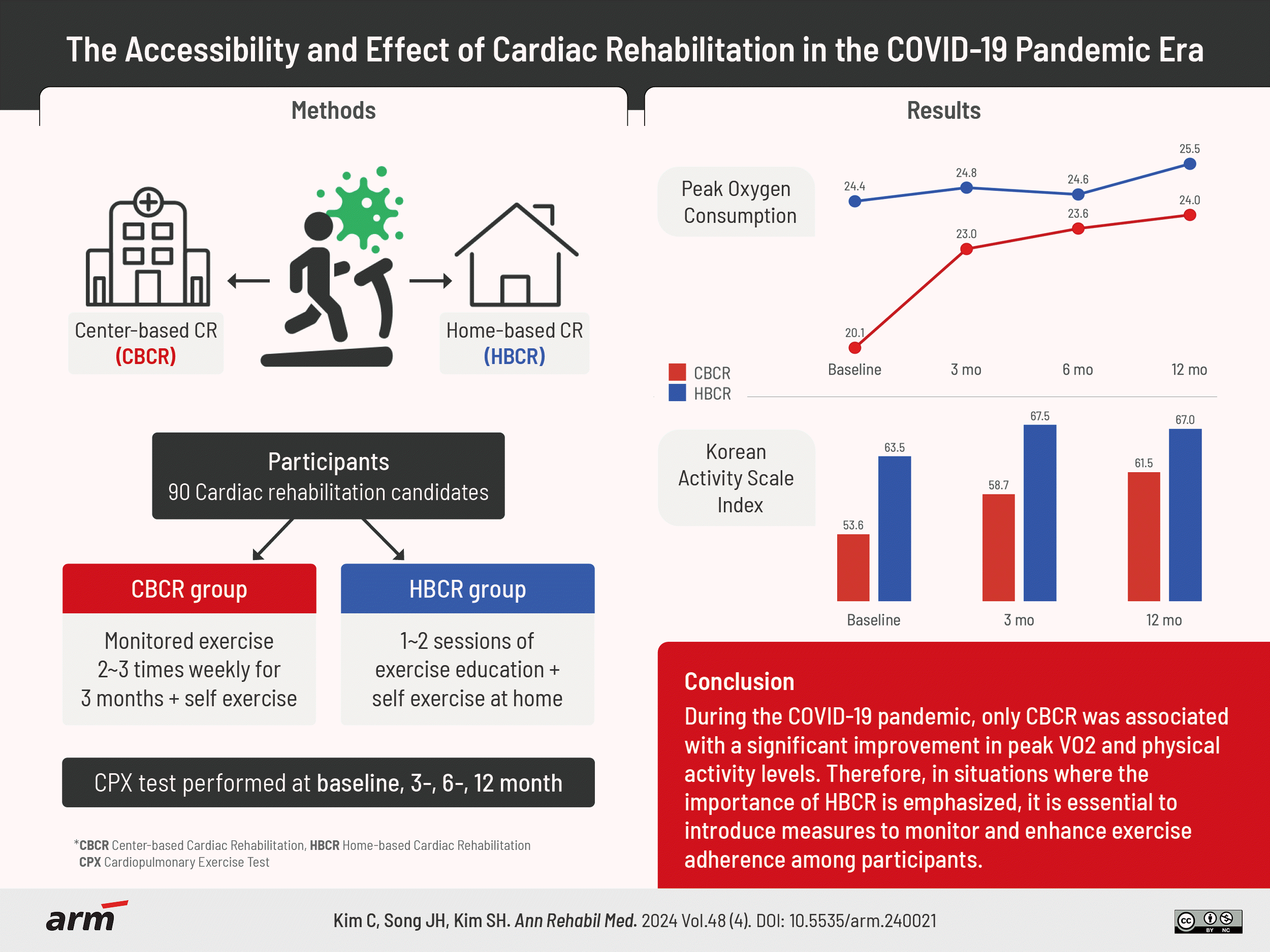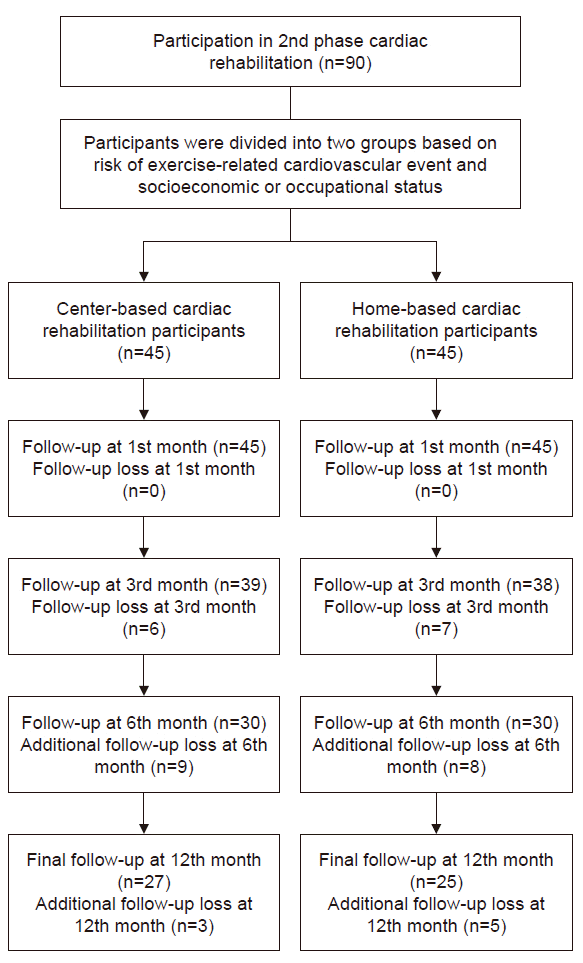1. Kim C, Sung J, Han JY, Jee S, Lee JW, Lee JH, et al. Current status of cardiac rehabilitation in the regional cardiocerebrovascular centers in Korea. J Clin Med. 2021; 10:5079.

2. Kim KH, Han JY. Fact sheet on cardiac rehabilitation for cardiovascular disease in South Korea. Ann Rehabil Med. 2023; 47:318–25.

3. Thomas RJ, Beatty AL, Beckie TM, Brewer LC, Brown TM, Forman DE, et al. Home-based cardiac rehabilitation: a scientific statement from the American Association of Cardiovascular and Pulmonary Rehabilitation, the American Heart Association, and the American College of Cardiology. Circulation. 2019; 140:e69–89.

4. Graversen CB, Johansen MB, Eichhorst R, Johnsen SP, Riahi S, Holmberg T, et al. Influence of socioeconomic status on the referral process to cardiac rehabilitation following acute coronary syndrome: a cross-sectional study. BMJ Open. 2020; 10:e036088.

5. Buckingham SA, Taylor RS, Jolly K, Zawada A, Dean SG, Cowie A, et al. Home-based versus centre-based cardiac rehabilitation: abridged Cochrane systematic review and meta-analysis. Open Heart. 2016; 3:e000463.

6. Dalal HM, Zawada A, Jolly K, Moxham T, Taylor RS. Home based versus centre based cardiac rehabilitation: Cochrane systematic review and meta-analysis. BMJ. 2010; 340:b5631.

7. Redfern J, Gallagher R, O'Neil A, Grace SL, Bauman A, Jennings G, et al. Historical context of cardiac rehabilitation: learning from the past to move to the future. Front Cardiovasc Med. 2022; 9:842567.

8. Kirwan R, Perez de Heredia F, McCullough D, Butler T, Davies IG. Impact of COVID-19 lockdown restrictions on cardiac rehabilitation participation and behaviours in the United Kingdom. BMC Sports Sci Med Rehabil. 2022; 14:67.

9. Varghese MS, Beatty AL, Song Y, Xu J, Sperling LS, Fonarow GC, et al. Cardiac rehabilitation and the COVID-19 pandemic: persistent declines in cardiac rehabilitation participation and access among US Medicare beneficiaries. Circ Cardiovasc Qual Outcomes. 2022; 15:e009618.

10. Ghisi GLM, Xu Z, Liu X, Mola A, Gallagher R, Babu AS, et al. Impacts of the COVID-19 pandemic on cardiac rehabilitation delivery around the world. Glob Heart. 2021; 16:43.

11. Kim C, Song JH, Kim SH. Validation of wearable digital devices for heart rate measurement during exercise test in patients with coronary artery disease. Ann Rehabil Med. 2023; 47:261–71.

12. Kim C, Kim SH, Suh MR. Accuracy and validity of commercial smart bands for heart rate measurements during cardiopulmonary exercise test. Ann Rehabil Med. 2022; 46:209–18.

13. Imran HM, Baig M, Erqou S, Taveira TH, Shah NR, Morrison A, et al. Home-based cardiac rehabilitation alone and hybrid with center-based cardiac rehabilitation in heart failure: a systematic review and meta-analysis. J Am Heart Assoc. 2019; 8:e012779.

14. Serdar CC, Cihan M, Yücel D, Serdar MA. Sample size, power and effect size revisited: simplified and practical approaches in pre-clinical, clinical and laboratory studies. Biochem Med (Zagreb). 2021; 31:010502.

15. Kang H. Sample size determination and power analysis using the G*Power software. J Educ Eval Health Prof. 2021; 18:17.

16. Fletcher GF, Ades PA, Kligfield P, Arena R, Balady GJ, Bittner VA, et al. Exercise standards for testing and training: a scientific statement from the American Heart Association. Circulation. 2013; 128:873–934.
17. Bhat AG, Farah M, Szalai H, Lagu T, Lindenauer PK, Visintainer P, et al. Evaluation of the American Association of Cardiovascular and Pulmonary Rehabilitation exercise risk stratification classification tool without exercise testing. J Cardiopulm Rehabil Prev. 2021; 41:257–63.

18. Sung J, On YK, Kim HS, Chae IH, Sohn DW, Oh BH, et al. Development of Korean activity scale/index (KASI). Korean Circ J. 2000; 30:1004–9.

19. Kim SH, Ahn J, Ock M, Shin S, Park J, Luo N, et al. The EQ-5D-5L valuation study in Korea. Qual Life Res. 2016; 25:1845–52.

20. Middleton WA, Savage PD, Khadanga S, Rengo JL, Ades PA, Gaalema DE. Benchmarking depressive symptoms in cardiac rehabilitation. J Cardiopulm Rehabil Prev. 2022; 42:163–71.

21. Laoutaris ID, Dritsas A, Adamopoulos S. Cardiovascular rehabilitation in the COVID-19 era: ‘a phoenix arising from the ashes?’. Eur J Prev Cardiol. 2022; 29:1372–4.

22. Sheng SP, Feinberg JL, Bostrom JA, Tang Y, Sweeney G, Pierre A, et al. Adherence and exercise capacity improvements of patients with adult congenital heart disease participating in cardiac rehabilitation. J Am Heart Assoc. 2022; 11:e023896.

23. Martin BJ, Arena R, Haykowsky M, Hauer T, Austford LD, Knudtson M, et al. Cardiovascular fitness and mortality after contemporary cardiac rehabilitation. Mayo Clin Proc. 2013; 88:455–63.

24. Kim C, Choi HE, Jang JH, Song JH, Kim BO. Do patients maintain proper long-term cardiopulmonary fitness levels after cardiac rehabilitation? A retrospective study using medical records. Ann Rehabil Med. 2021; 45:150–9.

25. Little KA, Smith JR, Medina-Inojosa JR, Chacin Suarez AS, Taylor JL, Hammer SM, et al. Predictors of changes in peak oxygen uptake after outpatient cardiac rehabilitation: importance of cardiac rehabilitation attendance. Mayo Clin Proc Innov Qual Outcomes. 2022; 6:428–35.

26. Jafri SH, Imran TF, Medbury E, Ursillo J, Ahmad K, Imran H, et al. Cardiovascular outcomes of patients referred to home based cardiac rehabilitation. Heart Lung. 2022; 52:1–7.

27. Nkonde-Price C, Reynolds K, Najem M, Yang SJ, Batiste C, Cotter T, et al. Comparison of home-based vs center-based cardiac rehabilitation in hospitalization, medication adherence, and risk factor control among patients with cardiovascular disease. JAMA Netw Open. 2022; 5:e2228720.

28. Epstein E, Patel N, Maysent K, Taub PR. Cardiac rehab in the COVID era and beyond: mHealth and other novel opportunities. Curr Cardiol Rep. 2021; 23:42.

29. Dunlay SM, Pack QR, Thomas RJ, Killian JM, Roger VL. Participation in cardiac rehabilitation, readmissions, and death after acute myocardial infarction. Am J Med. 2014; 127:538–46.
30. Williamson-Reisdorph CM, Larson WT, Porisch LB, Quindry JC. Hybrid and traditional cardiac rehabilitation in a rural area: a retrospective study. J Cardiopulm Rehabil Prev. 2023; 43:253–8.
31. Svendsen ML, Gadager BB, Stapelfeldt CM, Ravn MB, Palner SM, Maribo T. To what extend is socioeconomic status associated with not taking up and dropout from cardiac rehabilitation: a population-based follow-up study. BMJ Open. 2022; 12:e060924.
32. Shanmugasegaram S, Oh P, Reid RD, McCumber T, Grace SL. Cardiac rehabilitation barriers by rurality and socioeconomic status: a cross-sectional study. Int J Equity Health. 2013; 12:72.

33. Ravn MB, Uhd M, Svendsen ML, Ørtenblad L, Maribo T. Why do patients with ischaemic heart disease drop out from cardiac rehabilitation in primary health settings. A qualitative audit of patient charts. Front Rehabil Sci. 2022; 3:837174.

34. Kim SH, Ro JS, Kim Y, Leigh JH, Kim WS. Underutilization of hospital-based cardiac rehabilitation after acute myocardial infarction in Korea. J Korean Med Sci. 2020; 35:e262.

35. Carmody TP, Senner JW, Malinow MR, Matarazzo JD. Physical exercise rehabilitation: long-term dropout rate in cardiac patients. J Behav Med. 1980; 3:163–8.

36. Pecci C, Ajmal M. Cardiac rehab in the COVID-19 pandemic. Am J Med. 2021; 134:559–60.

37. Ramachandran HJ, Jiang Y, Tam WWS, Yeo TJ, Wang W. Effectiveness of home-based cardiac telerehabilitation as an alternative to Phase 2 cardiac rehabilitation of coronary heart disease: a systematic review and meta-analysis. Eur J Prev Cardiol. 2022; 29:1017–43.

38. Sari DM, Wijaya LCG. Cardiac rehabilitation via telerehabilitation in COVID-19 pandemic situation. Egypt Heart J. 2021; 73:31.

39. Kawada T. Clinical benefits in patients with home-based cardiac rehabilitation in the era of COVID-19 pandemic. Heart Lung. 2022; 52:197.





 PDF
PDF Citation
Citation Print
Print





 XML Download
XML Download